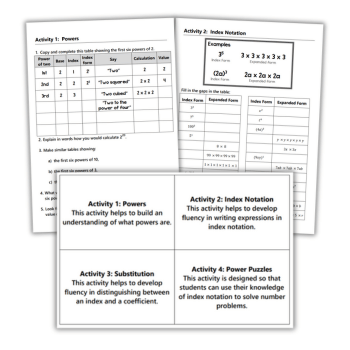This KS3 PDF contains four activities (and answers) for developing fluency in using index notation.
Activity 1: Powers
This activity helps to build an understanding of what powers are. Students need to copy and complete the table showing the first six powers of 2. They then need to explain in words how they would calculate 220, before making similar tables showing the first six powers of 10, 3 and a.
What would the first six powers of 1 look like? How about the first six powers of -1? What do students notice about negative bases?
What might the value of 20 or 2-1 be?
Activity 2: Index notation for KS3
This activity helps to develop fluency in writing expressions in index notation. Students need to fill in the gaps in the table, filling in either the missing index form or the missing expanded form.
Activity 3: Substitution
This activity helps to develop fluency in distinguishing between an index and a coefficient. Students need to evaluate the included expressions when x = 2 and y = 3, showing their workings.
Activity 4: Power Puzzles
This activity is designed so that students can use their knowledge of index notation to solve number problems. They need to write numbers in the included boxes to make the statements true. Can they find more than one solution?
Can they put three whole numbers in the included boxes to make the statement true? How many more examples can they find?
How to help students understand indices
It’s every maths teacher’s favourite topic – so why do students often end up misunderstanding it, asks Jo Morgan…
Students first see index notation in Year 5 when they are introduced to square numbers and cube numbers. In their Key Stage 2 SATs they may be asked questions such as “Work out 52 + 10” and “Write down a square number between 15 and 20”.
When our students first work with algebra at Key Stage 3, we pick up this topic directly from where the Key Stage 2 curriculum left off.
Moving from 32 to a2 and then onto higher powers, we generalise – teaching our students to interpret the meaning of an where n is any positive integer.
At this point, where clear definitions and consistent use of vocabulary are absolutely vital, I have to admit that I’ve been making a mistake for the entire time I’ve been a maths teacher.
See, I’ve been teaching my students that the raised number is called a power, index or exponent. Recently I found out that’s not actually correct. Thankfully, I also discovered that the majority of maths teachers say the same thing I do.
In fact, maths textbooks have been calling it a power for decades. It’s so commonplace that it’s become totally acceptable to refer to the raised number as a power. It’s not a power though. The whole thing – a base with an index – is a power.
I’m going to make a concerted effort to take more care over this vocabulary in future!
Deceptive simplicity
One of the things that we like about teaching indices is that it’s relatively easy to explain the underlying concepts, perhaps until we reach fractional indices where it gets a bit more abstract.
But the rest of the topic – index notation, index laws and even negative indices – is fairly straightforward to explain.
It also leads somewhere very important: the study of calculus at A level requires a sound understanding of indices.
However, the apparent simplicity of the underlying concepts means that we risk rushing through the content. And this is where we go wrong. We underestimate the complexity of the notation to novice learners.
Think about it: no tens are used in the calculation of 210. No wonder it’s confusing! Our students are used to being given clear symbolic instructions (x for multiply, + for add and so on), but here there are two numbers and no operation symbol. It’s new territory.
The big misconception
A failure to develop fluency in using index notation from the start leads to perhaps one of the most fundamental and frustrating misconceptions we see in secondary mathematics: the dreaded 32 = 6 and its algebraic partner in crime, a x a = 2a.
If you see your students making mistakes like this, you’ll be pleased to know that it’s not just you! This misconception has existed forever – maths textbooks from the late 1800s warn gravely that “the beginner must be careful to distinguish between coefficient and index”.
So the question is, how do we avoid it? Part of the problem is that index notation is often covered as a bit of an aside, popping up briefly in the middle of our introduction to algebra in Year 7. It would be far better to treat it as a topic in its own right.
Starting with some lessons on square numbers (try the delightful Rainbow Squares from MathPickle), we should then spend some time looking in depth at index notation – where it came from, why we use it, how we say it out loud, what it means, how it varies, where the common misconceptions arise, and how we can use it to solve problems.
The aim, amongst other things, is to develop absolute fluency in using index notation from as early as possible.
Jo Morgan is a maths teacher in South London. She writes the website resourceaholic.com and tweets as @mathsjem.
More maths resources
- KS3 maths games and lesson ideas
- GCSE maths games
- Factoring quadratics worksheets
- Key Stage 3 maths worksheets














